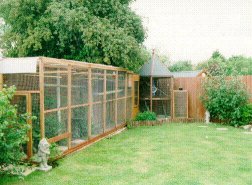Primate Enclosure Guidelines

28 feet (8.4m) long cage from Gordon Lawless
with 3 cotton-top marmosets in it
Before you start building your primate enclosure
- The bigger the enclosure the better. Don't use bird cages for any species!
- If possible create outdoor enclosures with a heated indoor enclosure.
- A cage can never be secured enough, don't underestimate the power of primates. A double entry door is a must for an outside enclosure.
Many monkeys show signs of boredom in captivity, therefore it's very important that you change their environment from time to time. Monkeys can spend many hours exploring their home. Try to use a lot of different items in their enclosure.
Indoor and Outdoor Primate Enclosure Enrichment Ideas
| Outdoor Enclosure | Indoor Enclosure |
|---|---|
|
Branches |
Branches |
Cleaning
You must clean your indoor enclosure (at least) every week. Droppings and excess food should be removed daily. Some monkeys are known to scent mark their environment (like marmosets), for these monkeys it's very important that you don't sterilize their cage at once (clean the nest box and the cage at different times). Use a mild disinfectant (you can buy this at your local pharmacist) to clean their enclosure.
Safety
When building an outdoor enclosure don't forget to provide some shade in the summertime and protection from wind and rain (cover a part of their enclosure with a roof). Never use chicken wire. Depending on the species use stainless steel welded wire (marmosets, tamarins, squirrels...) or chain link (capuchins,...). Don't forget that monkeys like capuchins are very strong animals where a chain link of at least 12 gauge strength (the lower the gauge the better) should be used. A safety entrance to prevent monkeys from escaping is certainly not a luxury.
Enclosure Size
Not only the width and length of an enclosure is important but the height of their enclosure can also be very important. Even small species like marmosets and tamarins prefer higher cages (they feel more secured). Therefore it's also very important that their nest box is placed as high as possible. The minimum height of a cage for capuchins, guenons, macaques and even for marmosets and tamarins is about 6 feet high (1.80m), for squirrel monkeys the minimum height is about 5 feet high (1.50m).
Vitamin D3
Most primates need unfiltered sunlight (vitamin D3) for their skeletal development, so if you don't have an outdoor enclosure for your primate(s) maybe it's more than a good idea to use Vita-Lites (replicate natural sunlight).
Floor Covering
The choice of floor type is also very important. You can use a drop tray, peat, sawdust, straw, dried leaves or wood chip floors for smaller cages. Larger cages are probably better off with cement floors, floors covered with linoleum, kitchen or bathroom floors (ceramic tile). Some people raise their cage high enough from the ground (wire bottoms) for easy raking cleanup underneath. This will also prevent a monkey from reaching for food or other items fallen onto the soil.
Toxic vs non-toxic Plants
When creating a natural environment with lots of plants, don't forget to use non-toxic plants! Here are a few examples of non-toxic plants: bamboo, rubber tree, willows, palm trees, elm, fig, hibiscus, pine, elder and silverberry. But watch out for toxic plants like American oak tree (European is ok), cedar, mistletoe and pencil tree.
Don't forget to use branches in your in- and/or outdoor enclosure. Use branches from for instance salix, pseudoacacia or sambuncus trees. Natural gum is very rich in vitamin D and Calcium and therefore recommended for most primates. However beware in spring when the gum is young, it may cause intestinal problems.